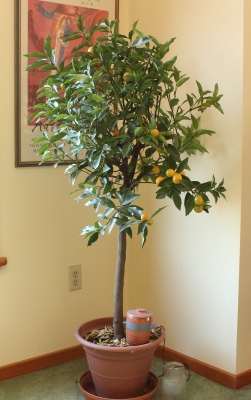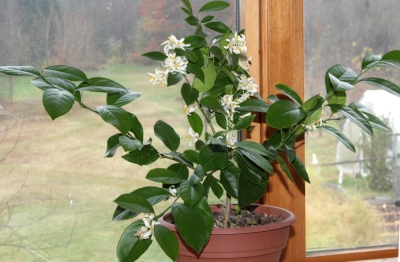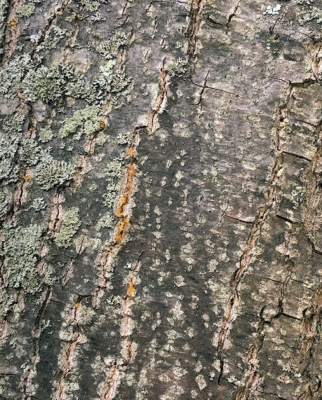And Never the Twains Shall Meet
Detente, Plant Style
“Oh, East is East, and West is West, and never the twain shall meet,” wrote Kipling a hundred years ago. Not so with respect to gardening. The Far East, spared the great sheets of ice that descended upon North America during the Ice Ages, has been a treasure trove of plants. Though distance, water, and culture kept the gardening worlds of the East and the West separate for millennia, the gap began to narrow just over two-hundred years ago.
The first plants to trickle out of China were those plants most accessible to foreigners — cultivated plants growing at and around seaport towns. It was not until the

Potted kumquat
middle of the nineteenth century that plant explorers pressed inland to open wide the treasure chest of wild and cultivated plants, many of which have found their way into my garden. These plant explorers are honored in plants that bear their names. Fortunella, or kumquats (the genus was changed recently, with kumquats now in Citrus), named for Robert Fortune. I grew kumquats, wintering them indoors at a sunny window, for many years. Citrus meyerei, the Meyer lemon, named for Frank Meyer; my two Meyer lemon plants, also at sunny windows, are just beginning to send out new shoots, soon, with flowers.
(There is a darker side to “East meets West.” Up until the middle of the 19th century, Japan was isolationist, which was not to the liking of U.S. commercial interests. President Millard Fillmore enlisted “Admiral” Matthew Perry to force his boats into Japan’s Edo Bay to intimidate the Japanese into opening their ports to American trade, as well as other concessions. This gunboat diplomacy was successful.)

Meyer lemon in bloom
Trans-Pacific Cousins
From the Far East came plants for which we had no counterparts, plants such as the gingko tree. There also came plants more, or at least equally, valuable as related plants found here. We have our redcedar (Juniperus virginiana); from China comes Chinese juniper (J. chinensis). Our redcedars turn drab brown in winter, but the Chinese species remain lush green throughout the year.
Common witchhazel (Hamemalis virginiana) and vernal witchhazel (H. vernalis) are understory shrubs of American forests; Asian forests likewise have two witchhazel

Arnold’s Promise witchhazel, today
species: Chinese (H. mollis) and the Japanese (H. japonica). The Asian species blossom at different times than the American species, so are useful for extending the period of witchhazel bloom. My Arnold’s Promise variety of witchhazel, a hybrid of the Chinese and the Japanese species, is in bloom right now although blooms often wait until midwinter to open
Where East really does meet West in gardening is in hybrids of Eastern and Western species. The hybrid tea rose, common in American gardens from New England to the Southwest, is one example. “Tea” in the name traces back to a tea-scented rose (Rosa gigantea) from China. For centuries, the Chinese hybridized this summer-flowering climber having huge, yellow flowers with a dwarf form of another species, R. chinensis. In the nineteenth century these hybrids were further hybridized with European roses to make hybrid tea roses.
Pest Control
American plant breeders sometimes have had to look across the Pacific to find plants with resistance to a disease originally brought to America from the East. Chestnut blight turned up at New York’s Bronx Zoo in 1906, and within fifty years, the tops of American chestnuts (Castanea dentata) were dead or dying in seven million acres of Appalachian forests. The roots, which are not affected by the blight, keep sprouting new shoots, which then die after a few years, but keep the blight fungus “fed.”

Blight on chestnut bark
Japanese chestnut (C. crenata) and Chinese chestnut (C. mollisima) evolved with the blight and show some resistance to it, so have been hybridized with the American species to produce blight-resistant trees, such as the variety Sleeping Giant. These trees lack the grandeur of the American chestnut, but they do make larger nuts. My chestnuts, the varieties Colossal, Marigoule, and Precoce Marigoule, are hybrids of European chestnut (C. sativa) and Japanese chestnut. They’re all blight resistant, but resistance is a matter of degree. My Colossal is finally succumbing to blight.
Dutch elm disease entered America via Europe, but entered Europe from Asia, probably about the time of World War I. Once again, Asian elm species — Chinese elm (Ulmus parviflora) and Siberian elm (U. pumila) — are resistant to the disease. Hybridization has produced such disease-resistant varieties as Patriot and Accolade.
Plants of Asia even have been useful in providing resistance to diseases not originating in Asia. Fireblight disease of pears was first noted in New York’s Hudson Valley at the end of the eighteenth century. Some Asian pear species are resistant to fireblight. Over a hundred years ago, hybrids between Asian and European pears that showed some resistance to blight were produced, at first by accident. These original hybrids did not taste very good, but did make pear-growing possible in blight-prone southeastern U.S.
The story isn’t yet over. Expeditions still return from such areas as remote villages and forest of China and the Himalayas to yield “new” plant treasures.


I have used many Japonicas in landscaping myself.
Many bulbs are from China & far east.
And think of all the flowers that have come from the East–types of roses, lilies, many more came centuries ago. These days, I get photos of exotic gesneriad and begonias, and even a blue fern from Indonesia (I think.)
I like that you have such a nice tree in doors and fruiting in such a little pot. I’d like to start one. Any ideas where I could get one?
Online, of course.
Wow, this is a super interesting post. I never knew that the far east escaped the ice sheets. That is a fascinating insight. Thanks for sharing!
Lee, hi
About the chestnuts. I grew up in the city, Kiev, Ukraine, where its main street is fully covered with chestnut trees. They are beautiful when blooming.
https://www.ukraine.com/blog/kiev-s-spectacular-horse-chestnut-trees/#:~:text=Kiev%E2%80%99s%20Spectacular%20Horse-Chestnut%20Trees%20Horse-chestnut%20trees%20%28Aeculus%20hippocastanum%29,prominent%20feature%20in%20Ukraine%E2%80%99s%20capital%20city%20of%20Kiev.
Here is a related image: https://2.bp.blogspot.com/-t8IgxHHAIKQ/UtEmw5zCsOI/AAAAAAAAA5Q/qCwJZC0tciU/s1600/cathedral+and+chestnuts.jpg
Those are horse chestnuts, beautiful trees but their nuts are not edible.
Yes, I don’t remember that anybody was eating them.
People have eaten then with out any “poisoning”. Also they are used as a medicinal.
Introducing plants from Asia has been a deeply mixed bag. While I also enjoy the Meyer lemon tree currently residing in my bathroom, introductions from the nursery trade are also how devastating diseases such as Dutch elm disease, chestnut blight came to North America. The nursery trade has also introduced insect pests such as emerald ash borer, Japanese beetles and more. And many invasive species were also introduced, often intentionally, by the nursery trade: Japanese knotweed, mile a minute weed, kudzu.
These introduced species have profoundly changed our landscapes, are devastating our natural environment, and are a profound threat to biodiversity.
Even relatively well behaved introduced plants are problematic, at least in the way we are currently using them. Non-native plants support many fewer insects. Higher tropic levels, such as birds, are deeply dependent on the insects that eat native plants. Without them, the cannot survive and reproduce successfully. Suburban landscapes dominated by introduced species are, effectively, green deserts; attractive, but largely devoid of life.
Humans are so abundant we have impacted every corner of the earth. We can no longer count on nature being somewhere else to support us. We need to bring ecological thinking home and weave the natural world back into our human landscapes. That means emphasizing native plants.
I certainly grow food plants with origins all over the world. But I also grow many unusual native edibles. And for ornamental plants, I heavily emphasize natives. There are so many beautiful plants that belong to my place, or at least nearby, I don’t see a need to grow large numbers of ornamental plants from far flung places that don’t contribute to the local ecosystem and risk bringing in new invasive species and diseases.
Of course there’s no “need” for beautiful exotic plants –except for those of us who are addicts. I need a formosa lily right now. I might also need a native baptisia. I try to support bees & bats & snakes & rattlesnake master & am trying to grow prairie smoke (though is doesn’t come from South Carolina.) I have Mexican salvias & Mexican petunias & native ruella & dayflower & greenandgold, also lots of pretty (shudder) hybrids. I need all of them.
Paragraph 4 seems to be a case of “never the main shall tweet”
The Chinese junipers, harbor Cedar (juniper) apple rust as much as Eastern red cedars ( juniperus virginiana) the alternate host for this apple disease. Be aware if you grow apples that aren’t resistant.
Thanks for the post. Informative and inspiring. I’m planning a few tropical (or subtropical) trees for an in ground greenhouse in Maryland. I’m wondering if trees might fare better planted in the ground (inside the greenhouse) or in pots taken in outside during the summer. I’d imagine planting in the ground would make an overall healthier tree but maybe you’d know some advantages of snow bird trees I’m not aware of.
I would suggest subtropical rather than tropical. To me, at least, tropical would require too much energy (heat) to thrive. Whether in ground or not depends also on the size of the greenhouse and ground insulation. Cold creeps in from the edges, so a smaller greenhouse has more percentage of cold soil.